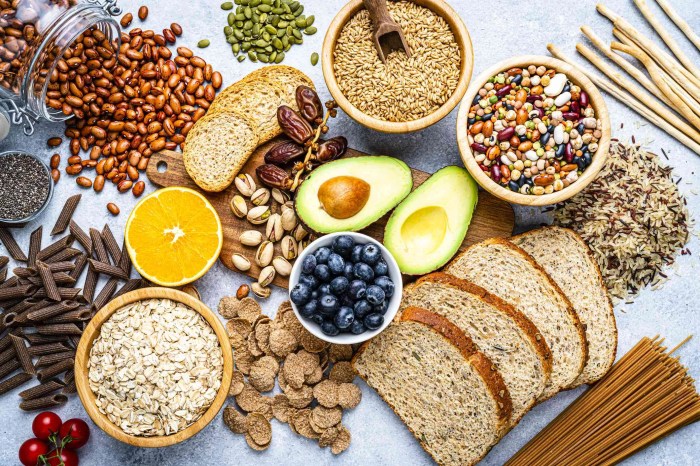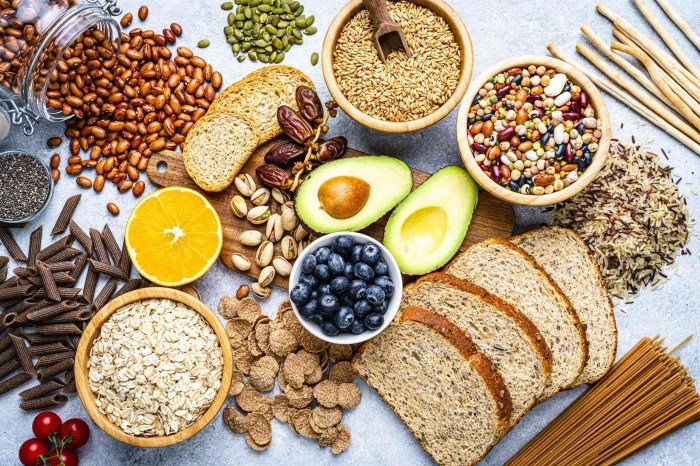Foods that you dont know are making you sweat more – Foods that you don’t know are making you sweat more can be surprisingly common culprits. From spicy dishes to seemingly harmless snacks, certain foods can trigger increased perspiration. Understanding the science behind these reactions can help you identify potential triggers and adjust your diet for a more comfortable experience.
This post dives deep into the connection between specific foods and sweating, exploring the mechanisms behind these responses, and the role of individual differences in how we react to different meals. We’ll also examine how dietary patterns, cooking methods, and environmental factors contribute to the equation. Get ready to uncover the hidden sweat-inducing foods in your kitchen!
Identifying Hidden Culprits

Sweating, a natural bodily function, can sometimes become excessive and uncomfortable. While often attributed to physical exertion or environmental factors, certain foods can surprisingly trigger increased perspiration. Understanding the underlying mechanisms behind this connection can empower us to make informed dietary choices and better manage our reactions to different foods.
Common Foods Associated with Increased Sweating
Several foods, seemingly innocuous, can inadvertently contribute to increased sweating. This is often due to the body’s complex physiological responses to specific components in these foods.
| Food Name | Potential Sweating Triggers | Underlying Mechanisms |
|---|---|---|
| Spicy Foods (e.g., chili peppers) | Capsaicin, the compound responsible for heat sensation, can stimulate the body’s thermoregulatory system. | Capsaicin activates nerve endings, leading to a perceived increase in body temperature. The body responds by increasing perspiration to cool down. |
| Processed Foods (e.g., cured meats, some sauces) | High sodium content, additives, and preservatives. | High sodium intake can lead to fluid retention, triggering the body’s need to release excess water through sweat. Additives and preservatives may have varying effects on the body’s metabolic processes, sometimes impacting thermoregulation. |
| High-Sodium Foods (e.g., canned soups, processed snacks) | Sodium, a key component in many processed foods. | Sodium plays a critical role in regulating fluid balance. High sodium intake can lead to water retention, forcing the body to eliminate excess fluid through sweat. This is part of the body’s natural response to maintain homeostasis. |
| Caffeine-Rich Foods (e.g., coffee, tea, chocolate) | Caffeine, a stimulant. | Caffeine acts as a stimulant, potentially increasing heart rate and blood flow. This increased cardiovascular activity can lead to a rise in body temperature, triggering the body’s sweating response. |
| Alcohol (e.g., beer, wine) | Alcohol’s diuretic effect and metabolic processes. | Alcohol has a diuretic effect, leading to increased urination and fluid loss. The body’s response can include increased sweating to compensate for this fluid loss. Furthermore, alcohol’s metabolism can produce heat, increasing body temperature and prompting the body to sweat. |
| Certain Fruits and Vegetables (e.g., some citrus fruits, spicy peppers) | High water content, specific compounds, or combination with other factors. | The high water content in some fruits can indirectly contribute to increased sweating by influencing fluid balance. Certain compounds in specific vegetables or fruits might stimulate the body’s thermoregulatory mechanisms. |
| Sugary Foods (e.g., candy, soda) | Rapid glucose absorption and metabolic responses. | The rapid absorption of glucose from sugary foods can lead to fluctuations in blood sugar levels. This metabolic response can trigger changes in body temperature, prompting sweating. |
| Fatty Foods (e.g., fried foods, processed meats) | Digestive processes and metabolic byproducts. | Digesting fatty foods can be a more energy-intensive process, potentially generating heat. Certain metabolic byproducts from the digestion of fats might also influence the body’s thermoregulation, leading to increased perspiration. |
| Spicy Foods (e.g., hot sauces) | Capsaicin and other bioactive compounds. | Capsaicin, a key component in many spicy foods, stimulates nerve endings, causing a perceived increase in body temperature. The body responds by increasing perspiration to reduce internal heat. |
| Foods High in Histamine (e.g., aged cheeses, fermented foods) | Histamine release and inflammatory responses. | Certain foods contain high levels of histamine. Histamine release can trigger inflammatory responses, and this reaction can contribute to increased body temperature and subsequent sweating. |
Comparing Sweating Effects Across Food Categories
The intensity and type of sweating reaction can vary depending on the category of food. Understanding these distinctions can help in pinpointing the cause of excessive sweating.
| Food Category | Sweating Effects | Examples |
|---|---|---|
| Spicy Foods | Often characterized by a localized, potentially more intense, sweating response in the face and upper body. | Chili peppers, hot sauces, curry dishes. |
| Processed Foods | Can lead to more generalized sweating, potentially accompanied by fluid retention and other physiological responses. | Cured meats, canned soups, processed snacks. |
| High-Sodium Foods | Sweating might be less localized and more general, often accompanied by feelings of fullness or discomfort. | Pickled foods, salty snacks, canned vegetables. |
Individual Variations and Reactions
Individual responses to food are far from uniform. Our bodies, influenced by a complex interplay of genetics, environment, and health conditions, process and react to dietary components in unique ways. This variability extends to sweating, making it challenging to pinpoint specific foods as universally problematic. Understanding these individual variations is crucial for identifying the root causes of unexpected sweat production.Our metabolic pathways and body chemistry dictate how we digest and utilize nutrients.
Some individuals might have a faster metabolism, leading to quicker processing of certain foods, while others might metabolize them more slowly. This difference in speed can significantly impact sweat production. Furthermore, individual sensitivities to specific food components, such as certain proteins or sugars, can also trigger diverse responses, including increased sweating.
Metabolic Differences and Sweat
Individual variations in metabolism play a significant role in how our bodies react to food. A faster metabolism may lead to a quicker breakdown of nutrients, potentially triggering a more pronounced sweating response in some individuals. Conversely, a slower metabolism could result in a prolonged digestive process, which might also influence sweat production, albeit possibly not as dramatically. Genetic predispositions can also play a critical role in metabolic efficiency and sweat response to specific foods.
Genetic Influences on Food Reactions
Genetic factors significantly influence our metabolic processes and the way our bodies react to different foods. Certain genes are linked to variations in enzyme activity, impacting how we process nutrients and metabolize specific components. This genetic predisposition can determine the likelihood of experiencing a sweat response after consuming particular foods. For example, variations in genes responsible for carbohydrate metabolism might contribute to different responses to high-sugar foods, leading to varying degrees of sweat production among individuals.
Environmental Factors and Sweat Production
Environmental factors, such as temperature and humidity, also interact with food intake to influence sweat production. Individuals in warmer climates might naturally sweat more, regardless of the food they consume. However, the interplay between environmental conditions and food intake can exacerbate or modify individual sweat responses. For example, eating spicy foods in a hot and humid environment could potentially lead to a more noticeable sweat response compared to the same food consumed in a cool, dry climate.
Health Conditions and Food Reactions
Certain health conditions can modify the body’s response to food and trigger increased sweating. For example, individuals with thyroid disorders often experience changes in metabolism, potentially leading to variations in sweat production. Similarly, those with diabetes might exhibit different responses to carbohydrates, as their blood sugar regulation mechanisms are affected. The presence of other underlying medical conditions could also alter an individual’s response to food and sweat production.
Examples of Individual Food Sensitivities, Foods that you dont know are making you sweat more
Individual sensitivities to specific foods can lead to a range of reactions, including increased sweating. For example, consuming high-fat foods may cause some individuals to sweat more, while others might not experience this effect. Similarly, individuals with lactose intolerance might experience a more pronounced sweat response after consuming dairy products due to their digestive distress. Specific reactions may be influenced by individual sensitivity levels and other factors.
Comparing Food Effects on Different Health Conditions
The effects of similar foods on individuals with different health conditions can vary considerably. For instance, individuals with thyroid issues might experience a more pronounced sweat response after consuming foods high in iodine, compared to those without thyroid conditions. Similarly, individuals with diabetes might sweat more after consuming high-carbohydrate foods due to the impact on their blood sugar levels.
Dietary Patterns and Sweating
Our bodies are intricate machines, and the foods we consume play a significant role in their function, including how much we sweat. Understanding the interplay between different food groups and our individual responses to them is crucial for managing perspiration levels and overall well-being. This exploration delves into the relationship between dietary patterns and sweat production, providing strategies for minimizing excessive sweating and maximizing bodily comfort.Dietary choices impact our internal temperature regulation mechanisms.
Some foods trigger a greater physiological response, leading to increased perspiration. This article examines how different food groups influence sweat production, and provides practical dietary strategies to mitigate excessive sweating.
The Role of Different Food Groups
Various food groups can influence sweat production differently. Carbohydrates, for example, are metabolized to provide energy, but their digestion and absorption can sometimes lead to increased metabolic heat, contributing to sweating. High-protein meals can also elevate core body temperature, potentially triggering a sweat response in some individuals. Foods high in fat, though often associated with satiety, can have variable effects on sweating depending on the individual and the type of fat consumed.
Sample Dietary Plan for Reduced Sweating
This sample plan focuses on foods known to have a lower sweat-inducing potential. It emphasizes whole, unprocessed foods and provides balanced nutrition. It’s crucial to remember that individual responses vary, so this plan serves as a guideline, and adjustments may be necessary based on personal experiences.
Ever wondered why you’re suddenly dripping? Certain foods, surprisingly, can ramp up your perspiration. Spicy dishes, for example, are notorious culprits. Speaking of things that heat you up, have you checked out the top flea markets in the US? 20 the best flea markets america offer a treasure trove of unique finds, and perhaps some surprisingly spicy snacks.
But back to sweating, alcohol and even some types of cheese can also contribute to your body’s temperature regulation struggles.
- Breakfast: Oatmeal with berries and a sprinkle of nuts. Oatmeal provides sustained energy without a significant spike in blood sugar, while berries offer vitamins and antioxidants. Nuts contribute healthy fats and protein. This combination promotes a balanced energy release, minimizing the potential for temperature fluctuations and sweating.
- Lunch: A salad with grilled chicken or fish, mixed greens, and a light vinaigrette dressing. Lean protein sources like chicken or fish provide sustained energy without contributing to a dramatic increase in body temperature, while fresh vegetables provide essential nutrients. The vinaigrette dressing adds flavor without being overly rich or heavy.
- Dinner: Baked salmon with roasted vegetables (broccoli, carrots, sweet potatoes). Salmon is rich in omega-3 fatty acids, promoting healthy bodily functions. The roasted vegetables are low in calories and rich in vitamins and minerals. This meal is light and balanced, supporting optimal body temperature regulation.
- Snacks: Fruits (apples, bananas), Greek yogurt, or a handful of almonds. These snacks provide a balanced mix of nutrients and fiber without triggering excessive sweating in most individuals. Avoid sugary snacks or processed foods, as they can lead to a spike in blood sugar and an increased metabolic rate, potentially leading to perspiration.
Potential Benefits of a Balanced Diet
A balanced diet with a focus on low-sweat-inducing foods can contribute to improved overall health and well-being. Maintaining a stable body temperature is essential for cognitive function, physical performance, and overall comfort. A balanced diet, by providing consistent energy and regulating metabolism, can help regulate core body temperature, thus minimizing the tendency to sweat excessively.
Dietary Approaches for Reducing Sweating
Several dietary approaches can help minimize the sweating response to specific foods. One strategy involves identifying trigger foods and gradually reducing their consumption to observe individual responses. A gradual reduction allows the body to adapt to the changes in dietary intake and minimize any potential discomfort. Another strategy is to increase fluid intake, especially during and after consuming potential sweat-inducing foods.
Adequate hydration can help regulate body temperature and prevent dehydration, reducing the severity of the sweating response. Furthermore, incorporating foods with cooling properties, such as cucumbers and melons, into the diet might help to maintain a lower body temperature, potentially reducing sweat production.
Food Components and Their Impact
Understanding how specific food components influence our body’s temperature regulation and sweating response is crucial for pinpointing hidden dietary triggers. This knowledge empowers us to make informed choices about what we eat and how our bodies react to different foods. Many factors play a role, and these will be explored further.Specific food components can significantly impact our body’s thermoregulatory mechanisms, sometimes leading to increased sweating.
This can manifest in different ways for different individuals, and understanding these variations is key to managing potential discomfort.
Ever wondered why you’re suddenly drenched in sweat? Certain foods, surprisingly, can ramp up your body temperature. Spicy dishes, for example, often contain ingredients that trigger a heat response. Similarly, caffeine can increase your body’s metabolic rate, leading to more perspiration. Want to improve your focus and concentration?
Learning how to build a consistent reading habit and actually finish the books you start is key. Check out this guide on how make reading habit and finish the books you want read 2 for tips and tricks. Knowing what foods to avoid can help you feel more comfortable and prevent those unexpected sweat sessions.
Spices and Their Sweating Effects
Spices, known for their aromatic qualities, often contain compounds that stimulate the body’s sweat glands. Capsaicin, the compound responsible for the heat in chili peppers, is a prime example. It activates the body’s nervous system, leading to vasodilation (widening of blood vessels) and increased blood flow to the skin. This increased blood flow helps dissipate heat, which can result in sweating.
Similarly, other spices like ginger and turmeric can trigger similar responses, though the intensity may vary greatly.
Caffeine’s Influence on Sweating
Caffeine, a widely consumed stimulant, is known to elevate body temperature and heart rate. These physiological changes can stimulate sweat production as the body attempts to maintain a stable internal temperature. The intensity of this response varies depending on individual sensitivity and the amount of caffeine consumed. High caffeine intake may lead to a noticeable increase in perspiration in some individuals.
Sugars and Sweating Reactions
Certain sugars, particularly high-glycemic index carbohydrates, can impact blood sugar levels. Fluctuations in blood sugar can indirectly affect body temperature regulation. When blood sugar spikes, the body may react by increasing sweat production to help cool itself down. The impact, however, can be subtle and may not be noticeable in every individual. The specific type of sugar and the individual’s metabolic response play a crucial role in the overall effect.
Salt and Its Impact on Sweating
Sodium, a crucial electrolyte, plays a vital role in maintaining fluid balance. A high sodium intake can lead to fluid retention, which can indirectly influence the body’s ability to regulate temperature and may result in increased sweating. This response is particularly noticeable when coupled with increased physical activity, as the body expends more energy and produces more heat.
It is important to note that the response can vary greatly between individuals.
Table: Varying Sweating Reactions to Caffeine Concentration
| Caffeine Concentration (mg) | Individual A (Reaction) | Individual B (Reaction) | Individual C (Reaction) |
|---|---|---|---|
| 50 | Mild sweating | No noticeable change | Slight increase in perspiration |
| 100 | Moderate sweating, slight discomfort | Increased heart rate, slight sweating | Significant sweating, noticeable discomfort |
| 150 | Intense sweating, significant discomfort | Elevated heart rate, heavy sweating | Extreme sweating, significant discomfort, potential for dehydration |
Food Preparation and Sweating
Food preparation methods play a significant role in how our bodies react to certain foods. Different cooking techniques alter the chemical composition of ingredients, impacting their digestibility and, consequently, our physiological responses, including sweating. Understanding these interactions can help individuals identify triggers and tailor their dietary choices to minimize discomfort.Different cooking methods can significantly alter the sweating response to foods.
Heat application, the use of specific seasonings, and the overall cooking process itself can affect the bioavailability of certain compounds and the overall metabolic load on the body. This leads to varying degrees of sweating depending on the food and the method of preparation.
Cooking Methods and Their Influence on Sweating
Cooking methods influence the release of various compounds during the cooking process, impacting the digestive process and potentially increasing sweating. Different techniques affect the food’s structure, breaking down or altering components. This breakdown can result in the release of certain chemicals, altering the body’s response.
Examples of Different Cooking Methods and Their Impact
Consider the same food cooked in different ways. For instance, grilled chicken might cause a more noticeable sweating response than baked chicken. Grilling, with its higher temperatures and direct heat, can lead to the Maillard reaction, producing compounds that some individuals may find more challenging to digest, triggering sweating. Baking, on the other hand, tends to be a more gentle cooking method that might have a less pronounced sweating effect.
Ever wondered why you’re suddenly drenched in sweat? Turns out, certain foods can be sneaky culprits! Spicy foods, for example, are notorious for upping your body temperature. And did you know that some seemingly innocent ingredients, like certain types of alcohol, can also contribute to excessive perspiration? Thinking about your well-being, it’s important to understand how your diet can affect your physical health.
If you’re looking for a deeper understanding of the relationships in your life, I highly recommend checking out this article on 20 things everyone deserves in a relationship. Ultimately, understanding your body and the foods that might be causing you to sweat more is key to maintaining a healthy lifestyle.
Correlation Table: Cooking Methods and Sweating
| Cooking Method | Potential Impact on Sweating | Example Food | Explanation |
|---|---|---|---|
| Grilling | Potentially higher sweating response | Steak | High heat and direct exposure to flames can lead to the formation of compounds that may trigger sweating in some individuals. |
| Baking | Potentially lower sweating response | Chicken | Baking involves lower temperatures and indirect heat, often resulting in less pronounced sweating compared to grilling. |
| Frying | Potentially higher sweating response | French Fries | High heat and oil absorption can alter the structure of foods and lead to increased sweating in some individuals. |
| Steaming | Potentially lower sweating response | Vegetables | Steaming preserves nutrients and often results in a less substantial sweating response compared to frying or grilling. |
| Boiling | Potentially moderate sweating response | Pasta | Boiling involves immersion in water and may not induce sweating in all cases. |
Beyond the Diet: Foods That You Dont Know Are Making You Sweat More

Sweating, a vital bodily function, is influenced by more than just the food we eat. Various factors play a role in regulating our body temperature and moisture levels. Understanding these factors, beyond the realm of dietary triggers, can offer a more comprehensive perspective on why some individuals experience increased perspiration.
Environmental Conditions and Sweating
Environmental factors significantly impact our body’s thermoregulation. Temperature and humidity are key elements in determining how much we sweat. High temperatures and high humidity create a challenging environment for the body to cool itself. This is because the body’s cooling mechanisms, primarily sweating, struggle to effectively dissipate heat when the air already holds a high moisture content.
- High Temperatures: When external temperatures rise, our bodies work harder to maintain a stable internal temperature. This increased effort leads to a greater production of sweat to facilitate evaporation and cooling. A hot summer day, for example, often results in more noticeable sweating compared to a cooler day.
- High Humidity: High humidity hinders the evaporation process. When the air is saturated with moisture, sweat doesn’t evaporate as readily, reducing its effectiveness in cooling the body. This can lead to a feeling of discomfort and increased sweating, even at relatively moderate temperatures. Coastal areas often experience this effect.
Physical Activity and Sweating
Physical activity is a significant contributor to sweating. Exercise generates heat as the body works to perform the required physical task. The increased metabolic rate during physical activity requires the body to increase its cooling mechanisms to maintain a stable core temperature. The intensity and duration of exercise directly correlate to the amount of sweat produced.
- Intensity of Exercise: High-intensity activities like running or weightlifting cause a more pronounced increase in core temperature and, consequently, a greater sweat response. The more strenuous the activity, the more the body relies on sweating to regulate its temperature.
- Duration of Exercise: Prolonged periods of exercise, whether moderate or intense, result in a larger volume of sweat production. The body’s need for cooling increases as the activity continues, leading to more sweat to regulate temperature.
Stress and Anxiety and Sweating
Stress and anxiety, while not directly related to physical exertion, can also trigger sweating. These emotional states activate the sympathetic nervous system, which is responsible for the body’s “fight or flight” response. This response can lead to a cascade of physiological changes, including increased heart rate, blood pressure, and, importantly, sweating.
- Stress Response: The stress response, mediated by hormones like adrenaline, prepares the body for immediate action. Sweating, in this context, is a physiological component of this heightened state of readiness.
- Anxiety and Sweating: Anxiety, a common emotional experience, can trigger the same physiological response as stress. The body may perceive a threat, even when no immediate danger is present, leading to increased perspiration. This is often seen in social situations or during performance-based activities.
Illustrative Examples of Sweating Triggers
Unveiling the hidden connections between food and perspiration can be surprisingly revealing. While we often associate sweating with physical exertion, certain foods can unexpectedly trigger a significant increase in perspiration, sometimes even mimicking symptoms of other health conditions. Understanding these triggers can help individuals identify potential dietary sensitivities and manage their overall well-being.The human body’s response to food is incredibly complex and varied.
Genetic predispositions, individual metabolisms, and even the timing of meals play a role in how our bodies process and react to different foods. This intricate interplay can sometimes manifest as an unusual increase in perspiration, making it crucial to observe patterns and note specific foods that seem to be linked to these reactions.
A Case Study: Spicy Sichuan Noodles and Sweating
Amelia, a 30-year-old woman, experienced intense sweating after consuming spicy Sichuan noodles. The meal, typically enjoyed without issue, prompted a sudden, profuse perspiration that left her feeling uncomfortable and anxious. The sweating lasted for several hours, even after the initial meal. This reaction was attributed to the high concentration of capsaicin, a compound responsible for the spiciness of Sichuan peppers, and the individual’s sensitivity to it.
Variability in Responses to Spicy Foods
Individuals react differently to the same spicy food. While Amelia experienced significant sweating, others might experience a mild flush or an increase in heart rate. This variation in responses underscores the crucial role of individual factors in determining the extent of a sweating reaction. Factors such as the quantity of the spicy food consumed, the individual’s overall health, and any underlying sensitivities contribute to the diverse outcomes.
For instance, someone with a pre-existing condition affecting their thermoregulation system might be more prone to a significant sweat response to a spicy food.
Misinterpretation of Sweating as Other Health Issues
The intense sweating triggered by a specific food can sometimes be mistaken for other health conditions. For instance, anxiety and panic attacks are often characterized by sweating. If an individual experiences a significant sweat response after eating a particular food, and has a history of anxiety, they might misinterpret the reaction as an anxiety attack, leading to unnecessary concern and potentially even seeking medical attention for a condition that isn’t necessarily present.
Careful observation and documentation of the food consumed before the sweating can help differentiate between the two.
Mistaking Food-Induced Sweating for Hyperhidrosis
Imagine Sarah, a 25-year-old who frequently experienced excessive sweating in her hands and feet, especially after eating certain foods rich in histamine. Initially, she believed she was suffering from hyperhidrosis, a condition characterized by excessive sweating. However, meticulous dietary tracking revealed a strong correlation between her sweating episodes and consumption of foods like aged cheeses and fermented products.
This insight led her to identify and manage her symptoms by avoiding those specific foods. This case highlights the importance of a detailed dietary analysis to pinpoint the true cause of excessive sweating.
Conclusion
In conclusion, understanding the interplay between food and sweating is key to personalized well-being. This exploration has revealed a complex relationship, highlighting how individual variations, food components, and preparation methods all play a role. By identifying your personal sweat triggers and adopting a balanced diet, you can manage your body’s temperature regulation more effectively and enjoy a more comfortable lifestyle.
The next time you reach for a particular food, remember the potential impact on your body’s response.











